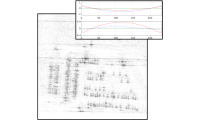Synthetic Aperture Radar (SAR) is an active microwave sensor technique that has the ability to produce high-resolution SAR images of terrain. SAR, unlike optical systems, is an active radar system and hence works in all weather conditions and at night. Therefore it has been widely applied in remote sensing and mapping.
A moving platform transmits series of coherent radar chirp pulses directed sideways of the flight trajectory. Coherent addition of the echoes received from the illuminated area yields so-called SAR raw data, from which, after SAR processing, pictorial data like SAR images, SAR video or 3D data are obtained.
For transmission of airborne SAR data from a platform to a receiving ground station the amount of SAR data has to be reduced to not exceed the available channel capacity. The interpretability of the pictorial data at the ground station, at least within regions of interest, should not be impaired by the data rate reduction.
First investigations have shown that the processing of SAR raw data to pictorial data must take place on board the platform, in order to stay within the channel capacity limit. On-board processing therefore comprises SAR processing resulting in focused pictorial data as well as data compression. The compressed bitstream can be sent to a ground station and can be decoded into focused pictorial data, such data which can directly be evaluated by human experts. Correspondingly, the investigated system comprises the following tasks:
1. Generating SAR pictorial data on UAVs
2. SAR-Autofocussing of moving ships
3. SAR-Video
4. 3D-SAR
5. Coding of SAR pictorial data
6. Usability-Based SAR System Assessment
1. SAR imaging assumes that the platform, e.g. an UAV, moves on a straight line at constant velocity. Real flight paths of UAVs differ from that assumption which, if uncompensated, create image artifacts. Compensation based on motion information is conceptually possible. But motion parameters as obtainable from on-board GPS (Global Positioning System) and INS (Inertial Navigation System) often lack accuracy, so that so called autofocus algorithms have to be used in order to obtain well-focused images. Our autofocus approach is based on a backprojection algorithm. (and)
2. On heavy swell, ship momement deviates by several meters from straight paths. Because of this nonlinear movement, ships are highly blurred in SAR images. The autofocus algorithm developed at the institute can estimate the movement of ships and generate sharply focused images, in which the type of ship can be identified.
3. By processing SAR raw data sectionwise a sequence of SAR images can be generated. In the SAR videos generated this way, moving objects can be detected.
4. SAR raw data can be used to generate 3D scenes in addition to images. . tbd Fabian
5. Current research in SAR coding focuses on the data rate reduction required to transmit the focused pictorial data within the limited channel capacity and without any loss of important image content. For an efficient coding a preprocessing has been developed which dynamically converts the focused SAR pictorial data into visually usable data. Because of the similarity of that data to electro-optical images, the investigated SAR codec is based on a standardized codec, e.g HEVC or VVC, extended by SAR specific reduction techniques.
6. Human evaluation of SAR pictorial data as an indirect means for usability-based assessment of the SAR systems from which the data arose, is time-consuming and costly. An assessment system is developed which aims at finding digital signal processing algorithms to simulate, complement and partly replace the human evaluation of SAR pictorial data.


